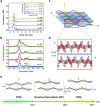Three-dimensional ultrafast charge-density-wave dynamics in CuTe
- PMID: 38493205
- PMCID: PMC10944522
- DOI: 10.1038/s41467-024-46615-y
Three-dimensional ultrafast charge-density-wave dynamics in CuTe
Abstract
Charge density waves (CDWs) involved with electronic and phononic subsystems simultaneously are a common quantum state in solid-state physics, especially in low-dimensional materials. However, CDW phase dynamics in various dimensions are yet to be studied, and their phase transition mechanism is currently moot. Here we show that using the distinct temperature evolution of orientation-dependent ultrafast electron and phonon dynamics, different dimensional CDW phases are verified in CuTe. When the temperature decreases, the shrinking of c-axis length accompanied with the appearance of interchain and interlayer interactions causes the quantum fluctuations (QF) of the CDW phase until 220 K. At T < 220 K, the CDWs on the different ab-planes are finally locked with each other in anti-phase to form a CDW phase along the c-axis. This study shows the dimension evolution of CDW phases in one CDW system and their stabilized mechanisms in different temperature regimes.
© 2024. The Author(s).
Conflict of interest statement
The authors declare no competing interests.
Figures




References
-
- Travaglini G, Wachter P. Charge-density-wave-phase-mode evidence in one-dimensional K0.3MoO3. Phys. Rev. B. 1984;30:1971–1978. doi: 10.1103/PhysRevB.30.1971. - DOI
-
- Vescoli V, Degiorgi L, Berger H, Forró L. Dynamics of correlated two-dimensional materials: the 2H-TaSe2 case. Phys. Rev. Lett. 1998;81:453. doi: 10.1103/PhysRevLett.81.453. - DOI
-
- Yoshikawa N, et al. Ultrafast switching to an insulating-like metastable state by amplitudon excitation of a charge density wave. Nat. Phys. 2021;17:909–914. doi: 10.1038/s41567-021-01267-3. - DOI
Grants and funding
- 112-2119-M-A49-012-MBK/Ministry of Science and Technology, Taiwan (Ministry of Science and Technology of Taiwan)
- 109-2112-M-009-020-MY3/Ministry of Science and Technology, Taiwan (Ministry of Science and Technology of Taiwan)
- 109-2124-M-009-003-MY3/Ministry of Science and Technology, Taiwan (Ministry of Science and Technology of Taiwan)
- 109-2119-M-002 -026 -MY3/Ministry of Science and Technology, Taiwan (Ministry of Science and Technology of Taiwan)
- 108-2112-M-002-013-MY3/Ministry of Science and Technology, Taiwan (Ministry of Science and Technology of Taiwan)
- 111-2124-M-213-001/Ministry of Science and Technology, Taiwan (Ministry of Science and Technology of Taiwan)
- 108-2112-M-002 -013 -MY3/Ministry of Science and Technology, Taiwan (Ministry of Science and Technology of Taiwan)
- 109-2119-M-002 -026 -MY3/Ministry of Science and Technology, Taiwan (Ministry of Science and Technology of Taiwan)
- 112-2124-M-006-009/Ministry of Science and Technology, Taiwan (Ministry of Science and Technology of Taiwan)
- 110-2112-M-032-014-MY3/Ministry of Science and Technology, Taiwan (Ministry of Science and Technology of Taiwan)
LinkOut - more resources
Full Text Sources

